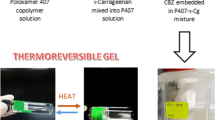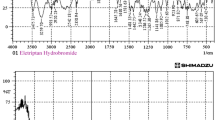Abstract
Purpose
Rufinamide is an anti-epileptic drug approved for use in children ≥ 4 years of age and in adults. It is marketed as Banzel in the USA. In 2015, Banzel received approval for use in pediatric patients (1–4 years of age) and the patent for which expires in 2023. It suffers from poor oral bioavailability, and hence, small amounts of the drug reach the brain. This has led to high and frequent dosage administration of rufinamide. This work aims to improve its brain bioavailability by formulating a nasal thermosensitive in situ gel using xyloglucan.
Methods
The formulation was optimized using rheometric analysis, texture analysis, in vitro, and in vivo studies. Pharmacokinetic studies in rats were carried out to assess direct nose to brain uptake for the optimized in situ gelling formulation of rufinamide and compared with intravenous bolus and aqueous nasal suspension of rufinamide. Finally, brain targeting indices % DTE, and % DTP were calculated.
Results
All the formulations showed gelation below 35 °C. The final formulation comprised 2.0% w/v xyloglucan, 0.01% v/v thiomersal (preservative), and rufinamide in suspended form. The %DTE values for the in-situ gel formulation and aqueous suspension were 1069.94 and 146.88, and the %DTP values were 90.65 and 31.91, respectively.
Conclusion
This work demonstrated the superiority of the nasal gel formulation over oral formulation of rufinamide. If translated to humans, this would definitely help patients suffering from epilepsy, especially pediatric population, in whose case, a high dose and frequent dosage administration via oral route is inconvenient.






Similar content being viewed by others
References
Baloglu E, Karavana SY, Senyigit ZA, Guneri T (2011) Rheological and mechanical properties of poloxamer mixtures as a mucoadhesive gel base. Pharm Dev Technol 16(6):627–636
Banzel FDA Product Information. FDA Prod. Inf. 2015
Bruschi ML (2015) Strategies to modify the drug release from pharmaceutical systems. Woodhead Publishing, Sawston
Charlton S, Jones NS, Davis SS, Illum L (2007) Distribution and clearance of bioadhesive formulations from the olfactory region in man: effect of polymer type and nasal delivery device. Eur J Pharm Sci 30(3–4):295–302
Dalvi AV, Uppuluri CT, Bommireddy EP, Ravi PR (2018) Design of experiments-based RP–HPLC bioanalytical method development for estimation of Rufinamide in rat plasma and brain and its application in pharmacokinetic study. J Chromatogr B 1102:74–82
Dauner K, Lißmann J, Jeridi S, Frings S, Möhrlen F (2012) Expression patterns of anoctamin 1 and anoctamin 2 chloride channels in the mammalian nose. Cell Tissue Res 347(2):327–341
Djupesland PG, Messina JC, Mahmoud RA (2014) The nasal approach to delivering treatment for brain diseases: an anatomic, physiologic, and delivery technology overview. Therap Deliv 5(6):709–733
Dong X (2018) Current strategies for brain drug delivery. Theranostics 8(6):1481
Grone BP, Baraban SC (2015) Animal models in epilepsy research: legacies and new directions. Nat Neurosci 18(3):339–343
Hanson LR, Frey WH (2008) Intranasal delivery bypasses the blood-brain barrier to target therapeutic agents to the central nervous system and treat neurodegenerative disease. BMC Neurosci 9(S3):S5
Harkema JR, Carey SA, Wagner JG (2006) The nose revisited: a brief review of the comparative structure, function, and toxicologic pathology of the nasal epithelium. Toxicol Pathol 34(3):252–269
Illum L (2004) Is nose-to-brain transport of drugs in man a reality? J Pharm Pharmacol 56(1):3–17
Kochumalayil J, Sehaqui H, Zhou Q, Berglund LA (2010) Tamarind seed xyloglucan–a thermostable high-performance biopolymer from non-food feedstock. J Mater Chem 20(21):4321–4327
Kozlovskaya L, Abou-Kaoud M, Stepensky D (2014) Quantitative analysis of drug delivery to the brain via nasal route. J Control Release 189:133–140
Merkus FW, van den Berg MP (2007) Can nasal drug delivery bypass the blood-brain barrier? Drugs R & D 8(3):133–144
Mircioiu C, Voicu V, Anuta V, Tudose A, Celia C, Paolino D et al (2019) Mathematical modeling of release kinetics from supramolecular drug delivery systems. Pharmaceutics 11(3):140
Mittal D, Ali A, Md S, Baboota S, Sahni JK, Ali J (2014) Insights into direct nose to brain delivery: current status and future perspective. Drug Deli 21(2):75–86
Nitta Y (2005) Gelation and gel properties of gellan gum and xyloglucan. J Biol Macromol 5(3):47–52
Pardeshi CV, Belgamwar VS (2013) Direct nose to brain drug delivery via integrated nerve pathways bypassing the blood–brain barrier: an excellent platform for brain targeting. Expert Opin Drug deliv 10(7):957–972
Poommarinvarakul S, Tattiyakul J, Muangnapoh C (2010) Isolation and rheological properties of tamarind seed polysaccharide from tamarind kernel powder using protease enzyme and high-intensity ultrasound. J Food Sci 75(5):E253–E260
Ravi PR, Aditya N, Patil S, Cherian L (2015) Nasal in-situ gels for delivery of rasagiline mesylate: improvement in bioavailability and brain localization. Drug Deliv 22(7):903–910
Ruby JJ, Pandey VP (2016) Formulation and evaluation of olanzapine loaded chitosan nanoparticles for nose to brain targeting an in vitro and ex vivo toxicity study. J Appl Pharm Sci 6:34–40
Ruel-Gariepy E, Leroux JC (2004) In situ-forming hydrogels—review of temperature-sensitive systems. Eur J Pharm Biopharm 58(2):409–426
Sakakibara CN, Sierakowski MR, Chassenieux C, Nicolai T, de Freitas RA (2017) Xyloglucan gelation induced by enzymatic degalactosylation; kinetics and the effect of the molar mass. Carbohyd Polym 174:517–523
Shafiur Rahman M, Al-Mahrouqi AI (2009) Instrumental texture profile analysis of gelatin gel extracted from grouper skin and commercial (bovine and porcine) gelatin gels. Int J Food Sci Nutr 60(sup7):229–242
Shorvon S, Perucca E, Engel J Jr (eds) (2015) The treatment of epilepsy. Wiley, New York
Sonvico F, Clementino A, Buttini F, Colombo G, Pescina S, Stanisçuaski Guterres S et al (2018) Surface-modified nanocarriers for nose-to-brain delivery: from bioadhesion to targeting. Pharmaceutics 10(1):34
Stützle M, Flamm J, Carle S, Schindowski K (2015) Nose-to-brain delivery of insulin for Alzheimer’s disease. ADMET and DMPK 3(3):190–202
Sunthar, P. (2010). Polymer rheology. In Rheology of complex fluids (pp. 171–191). Springer, New York, NY.
Tanaka A, Furubayashi T, Arai M, Inoue D, Kimura S, Kiriyama A et al (2018) Delivery of oxytocin to the brain for the treatment of autism spectrum disorder by nasal application. Mol Pharm 15(3):1105–1111
Vyas TK, Babbar AK, Sharma RK, Misra A (2005) Intranasal mucoadhesive microemulsions of zolmitriptan: preliminary studies on brain-targeting. J Drug Target 13(5):317–324
Wheless JW, Vazquez B (2010) Rufinamide: a novel broad-spectrum antiepileptic drug. Epilepsy Currents 10(1):1–6
Acknowledgements
Avantika Vijay Dalvi thanks the Indian Council of Medical Research for awarding a Senior Research Fellowship to pursue her doctoral studies. The authors thank the Central Analytical Laboratory of BITS-Pilani, Hyderabad campus, for providing Rheometer facilities.
Author information
Authors and Affiliations
Corresponding author
Ethics declarations
Conflict of interest
Avantika Vijay Dalvi, Chandra Teja Uppuluri, Radhika Rajiv Mahajan, Sumeet Vaibhav Katke, Vibha Sanjay Deshpande, and Punna Rao Ravi declare that they have no conflict of interest.
Research involving human and animal rights statement
All procedures performed in studies involving animals were in accordance with the ethical standards of the institution at which the studies were conducted, and ethical approval was obtained from the institute animal ethics committee (IAEC), BITS-Pilani, Hyderabad Campus (Regn. No.: 1912/PO/RE/S/16/CPCSEA).
Additional information
Publisher's Note
Springer Nature remains neutral with regard to jurisdictional claims in published maps and institutional affiliations.
Rights and permissions
About this article
Cite this article
Dalvi, A.V., Ravi, P.R., Uppuluri, C.T. et al. Thermosensitive nasal in situ gelling systems of rufinamide formulated using modified tamarind seed xyloglucan for direct nose-to-brain delivery: design, physical characterization, and in vivo evaluation. J. Pharm. Investig. 51, 199–211 (2021). https://doi.org/10.1007/s40005-020-00505-9
Received:
Accepted:
Published:
Issue Date:
DOI: https://doi.org/10.1007/s40005-020-00505-9




